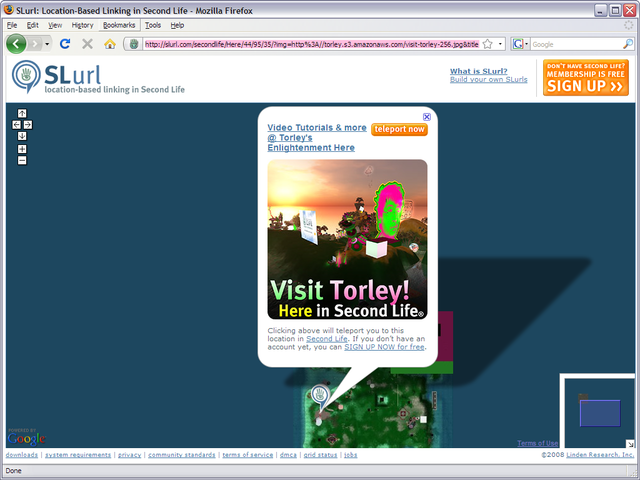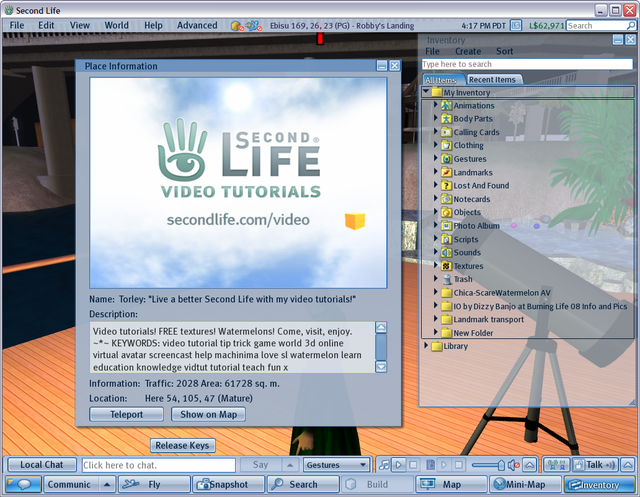Difference between revisions of "Using Second Life URLs (SLurls)"
m (Configured stable versioning for Using Second Life URLs (SLurls): [Precedence: Quality, Default: Stable]) |
|
(No difference)
| |
Revision as of 12:43, 15 October 2009
What is a SLurl?
You can't get to a webpage without knowing its URL (Uniform Resource Locator), commonly called a "link". Just like your web browser has bookmarks, in Second Life, we have landmarks. Since our virtual world is three-dimensional, landmarks contain a Region name and 3 positioning coordinates within that region. But what happens when you want to share a landmark outside of Second Life to promote your home, business, or other place?
A Second Life URL (SLurl) is a teleport link to a location in Second Life.
If you have Second Life installed, using a SLurl will automatically transport you to that location inworld. If you don't yet have Second Life, just click the SIGN UP link to go to a simple registration page. After registering and downloading the Second Life Viewer, you'll automatically start at the specified location. Watch this fun video tour to understand more:
<videoflash type="vimeo">1747404|640|480</videoflash>
The maps.secondlife.com and slurl.com websites are implemented using the Second Life Map API. If you have a website, you can use it as well to embed Second Life maps on your pages, in the same way you can embed Google Maps.
How it works
Use a SLurl to direct people to inworld locations like this:
- Create a SLurl, either using SLurl Builder, or "manually."
- Share the SLurl with a person who you want to tell about something in Second Life.
- They click the SLurl. It's a web link like any other.
- They'll see a http://slurl.com page and more info, if you provided it. Like this:
If the person doesn't have Second Life
The page at http://www.slurl.com will display a link to SIGN UP NOW for free. From the sign-up up page, they can quickly register, download the Second Life Viewer, and log in. When they first log in, they will initially arrive at the destination specified by the SLurl, not the default start location on Help Island. A quick tutorial will open upon their initial arrival to help them get started.
Providing new users the ability to sign up for Second Life directly from http://www.slurl.com is sometimes referred to as DirectSLurl. For more information, see the announcement of Direct SLurl.
If the person has Second Life
If the Second Life Viewer is not already running, it'll start.
- When they log in, they'll be at the location specified by the SLurl.
- If they're already logged in, a Place Information window opens in the Second Life Viewer:
- When they click the Teleport button in this window, they'll be instantly teleported to the location specified by the SLurl. Alternatively, they can click Show on Map to display the target location on the inworld map, or close the window if they don't want to be teleported.
Details
On Windows, a SLurl opens the most recently installed Viewer.
There isn't an immediate way to change which Viewer launches SLurls, so if you have the current released Viewer and a Release Candidate, whichever was installed most recently will start. You can change this by reinstalling the Viewer.
Every SLurl page's SLurl title and Teleport Now button link to a "secondlife://" address, which is an URI scheme which opens Second Life. This is different from the familiar "http://" used for webpages.
Tip: The reason why it's advantageous to post "http://" SLurls instead of direct "secondlife://" addresses in webpages is for the benefit of people who don't have Second Life yet. Giving them a "secondlife://" URL doesn't work, since it depends on SL being installed. A SLurl serves as a friendly intro to tell them about Second Life as-needed and where they'll be going. |
Constructing SLurls
The basic format for a SLurl is:
Where:
- <region> is the name of the destination region
- <x> and <y> are the east/west and north/south coordinates of the destination; <z> is the vertical (height) coordinate.
- The question mark (?) and the parameters that follow it are optional and provide additional information to be displayed in the slurl.com page; see Query string parameters for more informatiom.
Making beautiful SLurls
The first step to making beautiful SLurls is adding explanatory text and a picture to give it more context and information.
For example, say you've got an island in Second Life you want to invite people to. This base URL works:
But it tells nothing about the destination. Compare this to the following:
Click on the link to to see that it provides more descriptive information.
Use SLurlBuilder to easily make beautiful SLurls.
Query string parameters
Supply SLurl query string parameters to set the window title, image, and text. Parameters are just name=value pairs. Just like a standard URL, precede the first parameter pair with a question mark (?), and all subsequent parameter pairs with an ampersand (&).
| Parameter | Description | Example |
|---|---|---|
| title | Title text to display in the teleport window. | To specify the window title "Come to My Island!" use title=Come%20To%20My%20Island
|
| img | URL of image to display in teleport window. Must be a complete (absolute) URL, and preferably a small image of 256x256 pixels or less. | To display this example image, use img=http://slurl.com/examples/forsale.png |
| msg | Message text to display in the teleport window | To specify the message text "Your text here", use msg=Your%20text%20here |
Shortening SLurls
SLurls, especially if they have text and a picture included (see example), can get quite lengthy. This makes them difficult to paste into places like emails, which may have line breaks that mangle the SLurl. Plus, they look unsightly!
You can use a 3rd-party URL-shortening service to condense a SLurl and make it easier to share. There are dozens of these out there, including:
- Snurl - No relation to SLurl, but the similar URL and basic stats tracking makes it an easy choice.
- TinyURL - One of the first and most popular.
If you have a webserver with customizable redirect, you can do something similar. For example, try: http://torley.com/here and watch how the SLurl expands to its full length in your web browser's address bar.
Further information
|
You can send snapshots from Second Life to any email address. These are called postcards. All you need to do is:
Within minutes, they'll get it — with a SLurl! One popular popular way to use them is emailing them to social sites to show off! See example on Flickr, and notice how the "Visit Tiny" link is a SLurl! This is great, because the picture (said to be worth 1,000 words) gives you an idea what to expect. However, emailing straight to Flickr doesn't work as expected due to how postcard templates are arranged. To work around this, social sites like SLBuzz, Snapzilla, and Koinup have stepped in to provide better crossposting in addition to their own dedicated hosting. |
<videoflash>cBDAYizCvOI</videoflash> |
For more info on Second Life snapshots and how to make the best of postcard SLurls, see:
Using SLurls for easy travel
<videoflash>ceIzvl0TYVc</videoflash>
Changing your login location
<videoflash>7IQs_ljiAkQ</videoflash>
Teleport location history
<videoflash>DIAhBRaeNiE</videoflash>
See also
- What's a SLurl? ... and why you should care - From Second Life Tips & Tricks.
- Template:SLurl - Need to add SLurls to a wiki page here? This will help!
- Slurlblogger - Useful tool by Ordinal Malaprop which "can send notes with SLurls to email, or directly to a blog".

